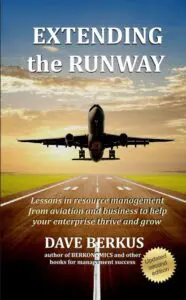Several years ago, I wrote a book entitled, Extending the Runway, using parallels to piloting a plane to equate to the process of creating and building a small company, making maximum use of resources to get to and beyond breakeven. It is worth revisiting the most

Extending the Runway book available at Amazon
important point of that book, which was written to prompt discussion between entrepreneurs, professional managers, and their boards of directors about issues that could unite them or strain the relationships between them.
The five resources boards and investors can add to a company
There are five types of resources a great board or active investor can add to a company. These are: time, money, relationships, context and process.
Time as a corporate asset
The longer it takes to produce and release a product, the more fixed overhead is consumed, and the runway of remaining cash diminishes. Expert help and good planning can reduce the time to market, saving cash in the process.
Money is what entrepreneurs expect from us
A board of directors is primarily responsible for oversight in the use of and the raising of money for the company. There is a fine line between loading the company with too much debt and diluting the shareholders too early with additional equity investments. But all agree that a good board will express its stewardship well by preventing the company from running out of money.
Further, just because someone volunteers to invest doesn’t make that person into a coach or expert, although many seem to think their investment gives them the right to be that coach or expert.
Relationships are often as valuable as an investment
[Email readers, continue here…] One reason for having an effective board or connected investors is to give the CEO a resource for tapping into great relationships that are owned by those individuals, so that the CEO can reach out and find help in areas most needed. In  the case of board members, if a board member has few appropriate relationships in his or her field of expertise or from past experience, then perhaps the board member is not appropriate for the company at this time. And if the board member refuses to volunteer or allow such relationships when needed by the CEO, that board member should be held to task by the other members of the board. And it is wise to have a private discussion with that person because sometimes the reason for refusal to make such introductions is because of a lack of confidence or passion relating to the company or its founder.
the case of board members, if a board member has few appropriate relationships in his or her field of expertise or from past experience, then perhaps the board member is not appropriate for the company at this time. And if the board member refuses to volunteer or allow such relationships when needed by the CEO, that board member should be held to task by the other members of the board. And it is wise to have a private discussion with that person because sometimes the reason for refusal to make such introductions is because of a lack of confidence or passion relating to the company or its founder.
How about context as a basis for decisions about growth?
Every good board has recruited at least one industry expert, often as the fifth or mutually approved outside member. With expertise in the company’s industry, that person can and should provide expert advice about the timing of the company’s product entrance and applicability in the industry it addresses. A great product at the wrong time or a poor product or service unable to address the needs of the industry will fail in the marketplace. That board member should be actively involved in questioning the positioning, marketing and even the design of the product to avoid just such a disaster.
Getting to product release: process insights
Here, most experienced board members can help to streamline the process of product development, manufacture, channel management and marketing. Knowing how to scale from test to release or how to complete a process more quickly saves money and time, making this knowledge as valuable as raising more money for the company, but without the cost in dilution or debt.
Use your board or build one if you don’t have one
Use your board to help you to navigate through control over these five resources. If you don’t have a viable, relevant board, build one no matter what your size and stage of development. One thing is usually sure: an entrepreneur cannot successfully do it all alone.









This is a review I posted on Amazon.com in 2007 and I see no reason to change anything I wrote therein:
A common-sense planning and management guide for entrepreneurs, funders and boards of directors
“Running out of runway” is a common term among early and mid-stage companies, who often risk going broke before they can bring a product to market or collect on sales quickly enough once the product hits the market.
Dave Berkus has written a mission-critical book for entrepreneurs, boards, and funding sources alike to help them anticipate and deal with common mistakes that cause companies to crash and burn.
Berkus speaks from the deep experience of a veteran entrepreneur, a veteran angel funder and early-stage venture capitalist, and a veteran pilot. He points out that pilots rarely have the luxury of learning from their own mistakes, and therefore must religiously review and focus on avoiding the mistakes of others. Since business mistakes tend to fall repeatedly into basic categories, readers are strongly encouraged to follow the pilots’ example.
Berkus points out that while cash is the No. 1 resource at risk, relationships, business processes, time and context all require equally close oversight.
He concludes with a checklist of questions and discussion points — itself worth the price of the book — that can help managers and boards evaluate their performance, anticipate potential turbulence and adjust accordingly.
“Extending the Runway” is brief but brims with common sense advice. Had it been available, this book would certainly have served me well in previous entrepreneurial ventures. It should be required reading for anyone thinking of launching or funding a startup venture — as well as those who are already at full throttle and find the end of the runway fast approaching.